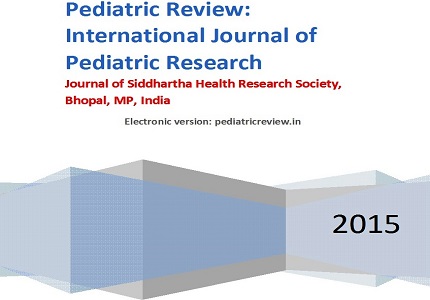Predictors of Hypoxemia in children (2-60 months) with lower respiratory tract infection
Abstract
Introduction: Acute lower respiratory tract infection specifically pneumonia, account for considerable number of deaths in under 5 children in our country. Hypoxemia is a dangerous sign which needs to be promptly treated. We have taken up this study in order to point out clinical predictors of hypoxemia so that they can be used at peripheral levels where pulse oxymetry the gold standard for measurement of percent oxygen saturation is unavailable. Materials and
Methods: The study was conducted in the pediatric intensive care unit of a medical college over a period of one year. This is a prospective cross sectional study. Children in the age group of 2-60 months were included in the study as per the inclusion criteria. Oxygen saturation of <95% was taken as cut off for hypoxemia.
Results: 150 children were studied out of which 35.3% had hypoxemia. Breathlessness, fever, irritability, inability to drink/breast feed, unusual sleepiness, convulsions were the presenting symptoms, out of these fever was present in 84% of children. The most frequent clinical sign was tachypnea (92%), followed by nasal flaring, chest indrawing and crepitations. There were 6 deaths, which were in the hypoxemic group, and no deaths were in the non-hypoxemic group.
Conclusion: No single sign is a good predictor of hypoxemia but a combination of signs when used can act as a surrogate for pulse oxymeter. These signs with high positive predictive value can be easily taught to primary health care workers in the peripheral health centers where pulse oxymeters are not available.
Downloads
References
2. Garenne M, Ronsmans C, Campbell H. Themagnitude of mortality from acuterespiratoryinfections in children under 5 years indeveloping countries. World Health StatisticsQuarterly 1992; 45: 180-191. [PubMed]
3. Bryce J, Boschi Pinto C, Shibuya K , Black RE. WHO estimate of the causes of death in children.Lancet. 2005.1;365(9465):1147-1152.PMID: 15794969. [PubMed]
4. Margolis PA, FerkolTW,MarsocciS,Super DM, Keyes LL, Mcnutt R, Harelli FE Jr .Accuracy of clinical examination in detecting hypoxemia in infants with respiratory illness. J Pediatr, 1994; 124(4): 552-560. [PubMed]
5. WHO pocket book of hospital care for children: Guidelines for the management of common illness with limited resources; 2005.
6. Leon C, Ricardo A, Stephen M, Mary Fran H. Pediatric Advanced Life support 7thedition.
7. F-MNCIFacility based integrated management of neonatal and childhood illness. Pg no 111-113.
8. Park K. Parkʾs Textbook of Preventive and Social medicine,21st Edition Pg 156. [PubMed]
9. Singhi S, Deep A, KaurH. Prevalence & predictors of hypoxemia in acute respiratory infections presenting topediatric emergency department. Indian J Crit Care Med 2003;7(2):118-123.http://www.ijccm.org/text.asp?2003/7/2/118/5739.
10. RakeshLodha, Prateek Singh Bhaduria ,AnoopVergheseKuttikat, MadhaviPuranik, SaurabhGupta,Pandey R M , Kabra S.K. Can clinical symptoms and signs accurately predict hypoxemia in children with acute lowerrespiratory tractinfections? Indian Pediatrics 2004;41(2):129-135. [PubMed]
11. Made Supartha, PutuSiadiPurniti, RoniNaning ,IdaBagusSubananda..Clinical predictors of hypoxemia in 1-5 year old children with pneumonia.PaediatricaIndonesiana. 2010;50( 6):355-360.http://paediatricaindonesiana.org/pdffile/50-6-8.pdf
12. Stanley Usen, Martin Weber, Kim Mulholland, ShabbarJaffar, AnslemOparaugo, Charles Omosighu, Richard Adegboda, Greenwood. Clinical predictors of hypoxemia in Gambian children with ALRI ,a prospective cohort study .BMJ. 1999; 318(7176):86-91.PMC27680. [PubMed]
13. Martin W Weber, Stanley Usen, Ayo Palmer, ShabbarJaffar, Kim Mulholland.Gambia. Predictors of hypoxemia in hospital admission with ALRI in a developing country. Archives Of Disease In Childhood1997;76(4) : 310-314.PMC1717166 . [PubMed]
14. Onyago F E, Steinhoff M C, Wafula E M,WariuaS,Musia J, Kitonyi J. Hypoxemia in young Kenyan children with acute lower respiratory tract infection. BMJ 1993; 306 :612-15. PMC 1676956. [PubMed]

Copyright (c) 2015 Author (s). Published by Siddharth Health Research and Social Welfare Society

This work is licensed under a Creative Commons Attribution 4.0 International License.


 OAI - Open Archives Initiative
OAI - Open Archives Initiative


